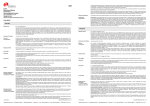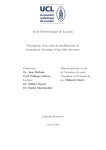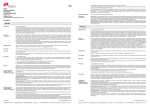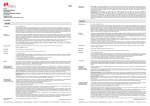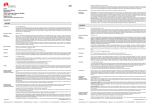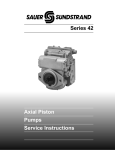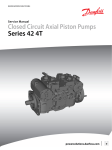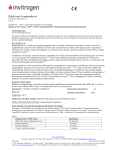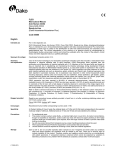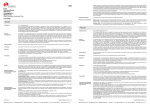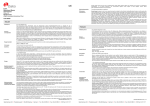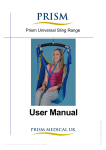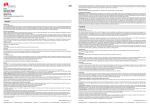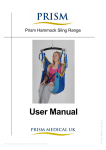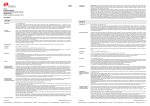Download FLEX Monoclonal Mouse Anti-Human Neurofilament Protein
Transcript
for information on re-programming of the protocol. Verify that the performance of the adjusted protocol is still valid by evaluating that the staining pattern is identical to the staining pattern described in “Performance characteristics”. Counterstaining in hematoxylin is recommended using EnVision FLEX Hematoxylin, (Dako Autostainer/Autostainer Plus) (Code K8018). Nonaqueous, permanent mounting medium is recommended. Positive and negative controls should be run simultaneously using the same protocol as the patient specimens. The positive control tissue should include colon and the cells/structures should display reaction patterns as described for this tissue in “Performance characteristics” in all positive specimens. The recommended negative control reagent is FLEX Negative Control, Mouse, (Dako Autostainer/Autostainer Plus) (Code IS750). FLEX Monoclonal Mouse Anti-Human Neurofilament Protein Clone 2F11 Ready-to-Use (Dako Autostainer/Autostainer Plus) Staining interpretation Cells labeled by the antibody display cytoplasmic staining. Performance characteristics Normal tissues: In sections of normal colon, the antibody labels some axons in the axon bundles of the plexus of Auerbach and Meissner (2, 6), whereas the perikarya of the ganglion cells are not immunostained (6). The large axons in the plexus of Auerbach show a moderate to strong staining reaction, whereas the isolated axons in the muscularis externa show a weak to moderate staining reaction. Abnormal tissues: In cases of Hirschsprung´s disease, the antibody strongly labeled axons in the plexus of Auerbach and Meissner in the aganglionic bowel segments (2, 6). In gangliogliomas, the antibody labeled neuronal processes in 10 of 13 tumors, whereas only in 5 of the cases, significant staining was observed in the neuronal perikarya (1). In an immunocytochemical study of intermediate filaments in Merkel cell tumors, 2 of 8 cases were positive (3). This clone does not label neuroblastomas. Code IS607 ENGLISH Intended use For in vitro diagnostic use. FLEX Monoclonal Mouse Anti-Human Neurofilament Protein, Clone 2F11, Ready-to-Use, (Dako Autostainer/ Autostainer Plus), is intended for use in immunohistotochemistry together with Dako Autostainer/Autostainer Plus instruments. This antibody labels neurons (axons) of the central and peripheral nervous system (1, 2), and is useful for the identification of tumors with neuronal differentiation (1, 3). The clinical interpretation of any staining or its absence should be complemented by morphological studies using proper controls and should be evaluated within the context of the patient's clinical history and other diagnostic tests by a qualified pathologist. Summary and explanation Neurofilaments (NFs) belong to the family of intermediate filaments (IFs) and are structural elements of the neuronal cytoskeleton in an interconnection with actin microfilaments, microtubules and other IFs. NFs are composed of three different subunits that are different, but related proteins: NF-L (70 kDa), NF-M (150-160 kDa) and NF-H (200 kDa). The antigenic determinants of each of the subunits may be unique or shared and each NF subunit is a separate gene product. During embryonic neurogenesis, the NF-L and NF-M subunits are coexpressed, whereas the activation of the NF-H subunit is delayed to the postnatal period. NF-M and NF-H subunits are unable to selfassemble and, typically, form co-polymers with NF-L (4, 5). FRANÇAIS Utilisation prévue Pour utilisation diagnostique in vitro. FLEX Monoclonal Mouse Anti-Human Neurofilament Protein, clone 2F11, Ready-to-Use, (Dako Autostainer/ Autostainer Plus), est destiné à une utilisation en immunohistochimie avec les instruments Dako Autostainer/Autostainer Plus. Cet anticorps marque les neurones (axones) du système nerveux central et périphérique (1, 2), et facilite l’identification des tumeurs présentant une différenciation neuronale (1, 3). L’interprétation clinique de toute coloration ou son absence doit être complétée par des études morphologiques en utilisant des contrôles appropriés et doit être évaluée en fonction des antécédents cliniques du patient et d’autres tests diagnostiques par un pathologiste qualifié. Résumé et explication Les neurofilaments (NF) appartiennent à la famille des filaments intermédiaires (FI). Ce sont des éléments structurels du cytosquelette neuronal qui interagissent avec les microfilaments d’actine, les microtubules et d’autres FI. Les NF sont composés de trois sous-unités constituées de protéines différentes mais liées : NF-L (70 kDa), NF-M (150-160 kDa) et NF-H (200 kDa). Les déterminants antigéniques de chaque sous-unité peuvent être uniques ou partagés et chaque sous-unité NF est un produit génique distinct. Au cours de la neurogenèse embryonnaire, les sous-unités NF-L et NF-M sont co-exprimées, alors que l’activation de la sous-unité NF-H n’intervient qu’après la naissance. Les sous-unités NF-M et NF-H sont incapables de s’auto-assembler et forment généralement des co-polymères avec la NF-L (4, 5). Refer to Dako’s General Instructions for Immunohistochemical Staining or the detection system instructions of IHC procedures for: 1) Principle of Procedure, 2) Materials Required, Not Supplied, 3) Storage, 4) Specimen Preparation, 5) Staining Procedure, 6) Quality Control, 7) Troubleshooting, 8) Interpretation of Staining, 9) General Limitations. Reagent provided Se référer aux Instructions générales de coloration immunohistochimique de Dako ou aux instructions du système de détection relatives aux procédures IHC pour plus d’informations concernant les points suivants : 1) Principe de procédure, 2) Matériels requis mais non fournis, 3) Conservation, 4) Préparation des échantillons, 5) Procédure de coloration, 6) Contrôle qualité, 7) Dépannage, 8) Interprétation de la coloration, 9) Limites générales. Ready-to-use monoclonal mouse antibody provided in liquid form in a buffer containing stabilizing protein and 0.015 mol/L sodium azide. Clone: 2F11 (6). Isotype: IgG1, kappa. Immunogen Neurofilament isolated from normal adult human brain (6). Specificity In immunoblotting, the antibody reacts with the 70 kDa subunit of neurofilament (6). Anticorps monoclonal de souris prêt à l’emploi fourni sous forme liquide dans un tampon contenant une protéine stabilisante et 0,015 mol/L d’azide de sodium. In immunohistochemistry, the antibody specifically labels neuronal cells (6). Clone : 2F11 (6). Isotype : IgG1, kappa. Réactifs fournis Precautions 1. For professional users. Immunogène Neurofilament isolé à partir de tissu sain de cerveau humain adulte (6). 2. This product contains sodium azide (NaN3), a chemical highly toxic in pure form. At product concentrations, though not classified as hazardous, sodium azide may react with lead and copper plumbing to form highly explosive build-ups of metal azides. Upon disposal, flush with large volumes of water to prevent metal azide build-up in plumbing. Spécificité Lors d’un immunoblot, l’anticorps réagit avec la sous-unité de 70 kDa du neurofilament (6). En immunohistochimie, l’anticorps marque de manière spécifique les cellules neuronales (6). Précautions 1. Pour utilisateurs professionnels. 3. As with any product derived from biological sources, proper handling procedures should be used. 4. Wear appropriate Personal Protective Equipment to avoid contact with eyes and skin. 2. Ce produit contient de l’azide de sodium (NaN3), produit chimique hautement toxique dans sa forme pure. Aux concentrations du produit, bien que non classé comme dangereux, l’azide de sodium peut réagir avec le cuivre et le plomb des canalisations et former des accumulations d’azides métalliques hautement explosifs. Lors de l’élimination, rincer abondamment à l’eau pour éviter toute accumulation d’azide métallique dans les canalisations. 5. Unused solution should be disposed of according to local, State and Federal regulations. Storage Store at 2-8 °C. Do not use after expiration date sta mped on vial. If reagents are stored under any conditions other than those specified, the conditions must be verified by the user. There are no obvious signs to indicate instability of this product. Therefore, positive and negative controls should be run simultaneously with patient specimens. If unexpected staining is observed which cannot be explained by variations in laboratory procedures and a problem with the antibody is suspected, contact Dako Technical Support. 3. Comme avec tout produit d’origine biologique, des procédures de manipulation appropriées doivent être respectées. 4. Porter un vêtement de protection approprié pour éviter le contact avec les yeux et la peau. 5. Les solutions non utilisées doivent être éliminées conformément aux réglementations locales et nationales. Specimen preparation including materials required but not supplied The antibody can be used for labeling formalin-fixed, paraffin-embedded tissue sections. Tissue specimens should be cut into sections of approximately 4 µm. Conservation Conserver entre 2 et 8 °C. Ne pas utiliser après la date de péremption imprimée sur le flacon. Si les réactifs sont conservés dans des conditions autres que celles indiquées, celles-ci doivent être validées par l’utilisateur. Il n’y a aucun signe évident indiquant l’instabilité de ce produit. Par conséquent, des contrôles positifs et négatifs doivent être testés en même temps que les échantillons de patient. Si une coloration inattendue est observée, qui ne peut être expliquée par un changement des procédures du laboratoire, et en cas de suspicion d’un problème lié à l’anticorps, contacter l’assistance technique de Dako. Préparation des échantillons y compris le matériel requis mais non fourni L’anticorps peut être utilisé pour le marquage des coupes de tissus inclus en paraffine et fixés au formol. L’épaisseur des coupes d’échantillons de tissu doit être d’environ 4 µm. Pre-treatment with heat-induced epitope retrieval (HIER) is required using Dako PT Link (Code PT100/PT101). For details, please refer to the PT Link User Guide. Optimal results are obtained by pretreating tissues using EnVision FLEX Target Retrieval Solution, High pH (50x) (Code K8010/K8004). Paraffin-embedded sections: Pre-treatment of formalin-fixed, paraffin-embedded tissue sections is recommended using the 3-in-1 specimen preparation procedure for Dako PT Link. Follow the pre-treatment procedure outlined in the package insert for EnVision FLEX Target Retrieval Solution, High pH (50x) (Code K8010/K8004). Note: After staining the sections must be dehydrated, cleared and mounted using permanent mounting medium. Deparaffinized sections: Pre-treatment of deparaffinized formalin-fixed, paraffin-embedded tissue sections is recommended using Dako PT Link and following the same procedure as described for paraffin-embedded sections. After staining the slides should be mounted using aqueous or permanent mounting medium. Un prétraitement avec démasquage d’épitope induit par la chaleur (HIER) est nécessaire avec le Dako PT Link (Réf. PT100/PT101). Pour plus de détails, se référer au Guide d’utilisation du PT Link. Des résultats optimaux sont obtenus en prétraitant les tissus à l’aide de la EnVision FLEX Target Retrieval Solution, High pH (50x) (Réf. K8010/K8004). Coupes incluses en paraffine : le prétraitement des coupes tissulaires fixées au formol et incluses en paraffine est recommandé à l'aide de la procédure de préparation d'échantillon 3-en-un pour le Dako PT Link. Suivre la procédure de prétraitement indiquée dans la notice de la EnVision FLEX Target Retrieval Solution, High pH (50x) (Réf. K8010/K8004). Remarque : après coloration, les coupes doivent être déshydratées, lavées et montées à l’aide d’un milieu de montage permanent. The tissue sections should not dry out during the treatment or during the following immunohistochemical staining procedure. For greater adherence of tissue sections to glass slides, the use of FLEX IHC Microscope Slides (Code K8020) is recommended. Staining procedure including materials required but not supplied The recommended visualization system is EnVision FLEX, High pH, (Dako Autostainer/Autostainer Plus) (Code K8010). The staining steps and incubation times are pre-programmed into the software of Dako Autostainer/Autostainer Plus instruments, using the following protocols: Template protocol: FLEXRTU2 (200 µL dispense volume) or FLEXRTU3 (300 µL dispense volume) Autoprogram: NFP (without counterstaining) or NFPH (with counterstaining) The Auxiliary step should be set to “rinse buffer” in staining runs with ≤10 slides. For staining runs with >10 slides the Auxiliary step should be set to “none”. This ascertains comparable wash times. All incubation steps should be performed at room temperature. For details, please refer to the Operator’s Manual for the dedicated instrument. If the protocols are not available on the used Dako Autostainer instrument, please contact Dako Technical Services. Optimal conditions may vary depending on specimen and preparation methods, and should be determined by each individual laboratory. If the evaluating pathologist should desire a different staining intensity, a Dako Application Specialist/Technical Service Specialist can be contacted (115223-002) Dako Denmark A/S Coupes déparaffinées : le prétraitement des coupes tissulaires déparaffinées, fixées au formol et incluses en paraffine, est recommandé à l’aide du Dako PT Link, en suivant la même procédure que pour les coupes incluses en paraffine. Après coloration, un montage aqueux ou permanent des lames est recommandé. IS607/EFG/MNI/2009.12.04 p. 1/4 | Produktionsvej 42 | DK-2600 Glostrup | Denmark | Tel. +45 44 85 95 00 | Fax +45 44 85 95 95 | CVR No. 33 21 13 17 Les coupes de tissus ne doivent pas sécher lors du traitement ni lors de la procédure de coloration immunohistochimique suivante. Pour une meilleure adhérence des coupes de tissus sur les lames de verre, il est recommandé d’utiliser des lames FLEX IHC Microscope Slides (Réf. K8020). Procédure de coloration y compris le matériel requis mais non fourni (115223-002) Dako Denmark A/S Le système de visualisation recommandé est le EnVision FLEX, High pH, (Dako Autostainer/Autostainer Plus) (Réf. K8010). Les étapes de coloration et d’incubation sont préprogrammées dans le logiciel des instruments Dako Autostainer/Autostainer Plus, à l’aide des protocoles suivants : IS607/EFG/MNI/2009.12.04 p. 2/4 | Produktionsvej 42 | DK-2600 Glostrup | Denmark | Tel. +45 44 85 95 00 | Fax +45 44 85 95 95 | CVR No. 33 21 13 17 Probenvorbereitungsverfahren für Dako PT Link wird empfohlen. Vorbehandlung gemäß der Beschreibung in der Packungsbeilage für EnVision FLEX Target Retrieval Solution, High pH (50x) (Code-Nr. K8010/K8004) durchführen. Hinweis: Nach dem Färben müssen die Schnitte dehydriert, geklärt und mit permanentem Einbettmedium auf den Objektträger aufgebracht werden. Protocole modèle : FLEXRTU2 (volume de distribution de 200 µL) ou FLEXRTU3 (volume de distribution de 300 µL) Autoprogram : NFP (sans contre-coloration) ou NFPH (avec contre-coloration). L’étape Auxiliary doit être réglée sur « rinse buffer » lors des cycles de coloration avec ≤10 lames. Pour les cycles de coloration de >10 lames, l’étape Auxiliary doit être réglée sur « none ». Cela confirme des temps de lavage comparables. Toutes les étapes d’incubation doivent être effectuées à température ambiante. Pour plus de détails, se référer au Manuel de l’opérateur spécifique à l'instrument. Si les protocoles ne sont pas disponibles sur l’instrument Dako Autostainer utilisé, contacter le service technique de Dako. Les conditions optimales peuvent varier en fonction du prélèvement et des méthodes de préparation, et doivent être déterminées par chaque laboratoire individuellement. Si le pathologiste qui réalise l’évaluation désire une intensité de coloration différente, un spécialiste d’application/spécialiste du service technique de Dako peut être contacté pour obtenir des informations sur la re-programmation du protocole. Vérifier que l'exécution du protocole modifié est toujours valide en vérifiant que le schéma de coloration est identique au schéma de coloration décrit dans les « Caractéristiques de performance ». Il est recommandé d’effectuer une contre-coloration à l’aide d’hématoxyline EnVision FLEX Hematoxylin, (Dako Autostainer/Autostainer Plus) (Réf. K8018). L’utilisation d’un milieu de montage permanent non aqueux est recommandée. Des contrôles positifs et négatifs doivent être réalisés en même temps et avec le même protocole que les échantillons du patient. Le contrôle de tissu positif doit comprendre le côlon et les cellules/structures doivent présenter des schémas de réaction tels que décrits pour ces tissus dans les « Caractéristiques de performance » pour tous les échantillons positifs. Le contrôle négatif recommandé est le FLEX Negative Control, Mouse, (Dako Autostainer/Autostainer Plus) (Réf. IS750). Interprétation de la coloration Les cellules marquées par l’anticorps présentent une coloration cytoplasmique. Caractéristiques de performance Tissus sains : Dans des coupes de côlon sain, l’anticorps marque certains axones dans les faisceaux d’axones des plexus d’Auerbach et de Meissner (2, 6), alors que le péricaryon des cellules ganglionnaires n’est pas coloré (6). Les grands axones du plexus d’Auerbach présentent une coloration modérée à forte, alors que la coloration des axones isolés dans la couche musculaire externe est faible à modérée. Entparaffinierte Schnitte: Eine Vorbehandlung der entparaffinierten, formalinfixierten, paraffineingebetteten Gewebeschnitte mit Dako PT Link nach demselben Verfahren, wie für die paraffineingebetteten Schnitte beschrieben, wird empfohlen. Die Objektträger nach dem Färben mit einem wässrigen oder permanenten Einbettmedium bedecken. Die Gewebeschnitte dürfen während der Behandlung oder des anschließenden immunhistochemischen Färbeverfahrens nicht austrocknen. Zur besseren Haftung der Gewebeschnitte an den Glasobjektträgern wird die Verwendung von FLEX IHC Microscope Slides (Code-Nr. K8020) empfohlen. Färbeverfahren und erforderliche, aber nicht mitgelieferte Materialien Das empfohlene Visualisierungssystem ist EnVision™ FLEX+, High pH, (Dako Autostainer/Autostainer Plus) (Code-Nr. K8010). Die Färbeschritte und Inkubationszeiten sind in der Software der Dako Autostainer/Autostainer Plus-Geräte mit den folgenden Protokollen vorprogrammiert: Matrixprotokoll: FLEXRTU2 (200 µL Abgabevolumen) oder FLEXRTU3 (300 µL Abgabevolumen) Autoprogram: NFP (ohne Gegenfärbung) oder NFPH (mit Gegenfärbung) Bei Färbedurchläufen mit höchstens 10 Objektträgern sollte der „Zusatz“-Schritt auf „Pufferspülgang“ eingestellt werden. Für Färbedurchläufe mit mehr als 10 Objektträgern den „Zusatz“-Schritt auf „Keine“ einstellen. Dieses gewährleistet vergleichbare Waschzeiten. Alle Inkubationsschritte sollten bei Raumtemperatur durchgeführt werden. Nähere Einzelheiten bitte dem Benutzerhandbuch für das jeweilige Gerät entnehmen. Wenn die Färbeprotokolle auf dem verwendeten Dako Autostainer-Gerät nicht verfügbar sind, bitte den Technischen Kundendienst von Dako verständigen. Optimale Bedingungen können je nach Probe und Präparationsverfahren unterschiedlich sein und sollten vom jeweiligen Labor selbst ermittelt werden. Falls der beurteilende Pathologe eine andere Färbungsintensität wünscht, kann ein Anwendungsspezialist oder Kundendiensttechniker von Dako bei der Neuprogrammierung des Protokolls helfen. Die Leistung des angepassten Protokolls muss verifiziert werden, indem gewährleistet wird, dass das Färbemuster mit dem unter „Leistungsmerkmale“ beschriebenen Färbemuster identisch ist. Die Gegenfärbung in Hämatoxylin sollte mit EnVision™ FLEX Hematoxylin (Dako Autostainer/Autostainer Plus) (Code-Nr. K8018) ausgeführt werden. Empfohlen wird ein nichtwässriges, permanentes Fixiermittel. Positiv- und Negativkontrollen sollten zur gleichen Zeit und mit demselben Protokoll wie die Patientenproben getestet werden. Das positive Kontrollgewebe muss Dickdarmzellen enthalten, und die Zellen/Strukturen müssen in allen positiven Proben die für dieses Gewebe unter „Leistungsmerkmale“ beschriebenen Reaktionsmuster aufweisen. Das empfohlene Negativ-Kontrollreagenz ist FLEX Negative Control, Mouse, (Dako Autostainer/Autostainer Plus) (Code-Nr. IS750). Tissus tumoraux : Dans les cas de maladie de Hirschsprung, l’anticorps marque fortement les axones des plexus d’Auerbach et de Meissner dans les segments intestinaux aganglionnaires (2, 6). Dans les gangliogliomes, l’anticorps marque les processus neuronaux dans 10 tumeurs sur 13, mais dans 5 cas seulement, une coloration significative a été observée dans les péricaryons neuronaux (1). Dans une analyse immunocytochimique des filaments intermédiaires des tumeurs à cellules de Merkel, 2 cas sur 8 sont positifs (3). Ce clone ne marque pas les neuroblastomes. DEUTSCH Zweckbestimmung Zur In-vitro-Diagnostik. Auswertung der Färbung Mit diesem Antikörper markierte Zellen weisen ein zytoplasmatisches Färbemuster auf. Leistungsmerkmale Gesundes Gewebe: In Schnitten von gesundem Darmgewebe markiert der Antikörper einige Axone in den Axonbündeln des Plexus Auerbach und Plexus Meissner (2, 6), während die Perikarya der Ganglionzellen nicht immungefärbt werden (6). Die großen Axone im Plexus Auerbach zeigen eine mäßige bis starke Färbereaktion, die isolierten Axone in der Muscularis externa dagegen nur eine schwache bis mäßige Färbereaktion. Pathologisches Gewebe: In Fällen von Hirschsprung-Krankheit werden die Axone im Auerbach- und Meissner-Plexus in den aganglionären Darmabschnitten durch den Antikörper stark gefärbt (2, 6). In Gangliogliomen markierte der Antikörper in 10 von 13 Tumoren neuronale Prozesse, während in nur 5 Fällen eine signifikante Färbung in den neuronalen Perikarya auftrat (1). In einer immunzytochemischen Studie von intermediären Filamenten in Merkel-Zelltumoren waren 2 von 8 Fällen positiv (3). Dieser Klon markiert keine Neuroblastome. FLEX Monoclonal Mouse Anti-Human Neurofilament Protein, Clone 2F11, Ready-to-Use, (Dako Autostainer/ Autostainer Plus) ist zur Verwendung in der Immunhistochemie in Verbindung mit Dako Autostainer/Autostainer Plus-Geräten bestimmt. Dieser Antikörper markiert Neuronen (Axonen) des zentralen und peripheren Nervensystems (1, 2) und dient zur Erkennung von Tumoren mit neuronaler Differenzierung (1, 3). Die klinische Auswertung einer eventuell eintretenden Färbung sollte durch morphologische Studien mit ordnungsgemäßen Kontrollen ergänzt werden und von einem qualifizierten Pathologen unter Berücksichtigung der Krankengeschichte und anderer Diagnostiktests des Patienten vorgenommen werden. Zusammenfassung und Erklärung Neurofilamente (NF) gehören zur Familie der Intermediärfilamente (IF). Sie sind Strukturelemente des neuronalen Zytoskeletts und sind mit Aktin-Mikrofilamenten, Mikrotubuli und anderen IF vernetzt. NF bestehen aus drei unterschiedlichen, aber verwandten Untereinheiten (Proteinen): NF-L (70 kDa), NF-M (150–160 kDa) und NF-H (200 kDa). Die Antigendeterminanten jeder einzelnen Untereinheit können spezifisch oder unspezifisch sein, dabei ist jede NF-Untereinheit ein eigenständiges Genprodukt. Während der embryonischen Neurogenese werden die NF-L- und NF-M-Untereinheiten koexprimiert, während die Aktivierung der NF-H-Untereinheit bis zur postnatalen Phase hinausgezögert wird. NF-M- und NF-H-Untereinheiten können sich nicht selbst zusammenfügen und formen typischerweise Co-Polymere mit NF-L (4, 5). References/ Références/ Literatur Folgende Angaben bitte den Allgemeinen Richtlinien zur immunhistochemischen Färbung von Dako oder den Anweisungen des Detektionssystems für IHC-Verfahren entnehmen: 1) Verfahrensprinzip, 2) Erforderliche, aber nicht mitgelieferte Materialien, 3) Aufbewahrung, 4) Vorbereitung der Probe, 5) Färbeverfahren, 6) Qualitätskontrolle, 7) Fehlersuche und -behebung, 8) Auswertung der Färbung, 9) Allgemeine Beschränkungen. Geliefertes Reagenz Gebrauchsfertiger, monoklonaler Maus-Antikörper in flüssiger Form in einem Puffer, der stabilisierendes Protein und 0,015 mol/L Natriumazid enthält. Klon: 2F11 (6). Isotyp: IgG1, Kappa. Immunogen Aus gesundem menschlichem Gehirn Erwachsener isoliertes Neurofilament (6). Spezifität Beim Immunblotting reagiert der Antikörper mit der 70-kDa-Untereinheit des Neurofilaments (6). 1. Diepholder HM, Schwechheimer K, Mohadjer M, Knoth R, Volk B. A clinicopathologic and immunomorphologic study of 13 cases of ganglioglioma. Cancer 1991;68:2192-2201. 2. Luider TM, van Dommelen MW, Tibboel D, Meijers JH, Ten Kate FJ, Trojanowski JQ, et al. Differences in phosphorylation state of neurofilament proteins in ganglionic and aganglionic bowel segments of children with Hirschsprung’s disease. J Pediatr Surg 1992; 27: 815-9. 3. Van Muijen GNP, Ruiter DJ, Warnaar SO. Intermediate filaments in Merkel cell tumors. Hum Pathol 1985;16:590-5. 4. Schlaepfer WW. Neurofilaments: structure, metabolism and implications in disease. J Neuropathol Exp Neurol 1987;46:117-29. 5. Herrmann H, Aebi U. Intermediate filaments and their associates: multi-talented structural elements specifying cytoarchitecture and cytodynamics. Curr Opin Cell Biol 2000; 12:79-90. 6. Klück P, van Muijen GNP, van der Kamp AWM, Tibboel D, van Hoorn WA, Warnaar SO, et al. Hirschsprung's disease studied with monoclonal antineurofilament antibodies on tissue sections. Lancet 1984;i: 652-4. Explanation of symbols/ Légende des symboles/ Erläuterung der Symbole Temperature limitation Limites de température Use by Utiliser avant 1. Nur für Fachpersonal bestimmt. Catalogue number Référence catalogue Bestellnummer Zulässiger Temperaturbereich Verwendbar bis 2. Dieses Produkt enthält Natriumazid (NaN3), eine in reiner Form äußerst giftige Chemikalie. Natriumazid kann auch in als ungefährlich eingestuften Konzentrationen mit Blei- und Kupferrohren reagieren und hochexplosive Metallazide bilden. Nach der Entsorgung stets mit viel Wasser nachspülen, um Metallazidansammlungen in den Leitungen vorzubeugen. In vitro diagnostic medical device Dispositif médical de diagnostic in vitro In-Vitro-Diagnostikum Contains sufficient for <n> tests Contenu suffisant pour <n> tests Manufacturer Fabricant Inhalt ausreichend für <n> Tests Hersteller Consult instructions for use Voir les instructions d’utilisation Gebrauchsanweisung beachten Batch code Numéro de lot In der Immunhistochemie markiert der Antikörper spezifisch neuronale Zellen (6). Vorsichtsmaßnahmen 3. Wie alle Produkte biologischen Ursprungs müssen auch diese entsprechend gehandhabt werden. 4. Geeignete Schutzkleidung tragen, um Augen- und Hautkontakt zu vermeiden. 5. Nicht verwendete Lösung ist entsprechend örtlichen, bundesstaatlichen und staatlichen Richtlinien zu entsorgen. Aufbewahrung Bei 2–8 °C aufbewahren. Nach Ablauf des auf dem Fläschch en aufgedruckten Verfalldatums nicht mehr verwenden. Werden die Reagenzien unter anderen als den angegebenen Bedingungen aufbewahrt, müssen diese Bedingungen vom Benutzer validiert werden. Es gibt keine offensichtlichen Anzeichen für eine eventuelle Produktinstabilität. Positiv- und Negativkontrollen sollten daher zur gleichen Zeit wie die Patientenproben getestet werden. Falls es zu einer unerwarteten Färbung kommt, die sich nicht durch Unterschiede bei Laborverfahren erklären lässt und auf ein Problem mit dem Antikörper hindeutet, ist der technische Kundendienst von Dako zu verständigen. Vorbereitung der Probe und erforderliche, aber nicht mitgelieferte Materialien Der Antikörper eignet sich zur Markierung von formalinfixierten und paraffineingebetteten Gewebeschnitten. Gewebeproben sollten in Schnitte von ca. 4 µm Stärke geschnitten werden. Die Vorbehandlung durch hitzeinduzierte Epitopdemaskierung (HIER) mit Dako PT Link (Code-Nr. PT100/PT101) ist erforderlich. Weitere Informationen hierzu siehe PT Link-Benutzerhandbuch. Optimale Ergebnisse können durch Vorbehandlung der Gewebe mit EnVision FLEX Target Retrieval Solution, High pH (50x) (Code-Nr. K8010/K8004) erzielt werden. Paraffineingebettete (115223-002) Dako Denmark A/S Chargenbezeichnung Schnitte: Die Vorbehandlung der formalinfixierten, paraffineingebetteten Schnitte mit dem 3-in-1IS607/EFG/MNI/2009.12.04 p. 3/4 | Produktionsvej 42 | DK-2600 Glostrup | Denmark | Tel. +45 44 85 95 00 | Fax +45 44 85 95 95 | CVR No. 33 21 13 17 (115223-002) Dako Denmark A/S IS607/EFG/MNI/2009.12.04 p. 4/4 | Produktionsvej 42 | DK-2600 Glostrup | Denmark | Tel. +45 44 85 95 00 | Fax +45 44 85 95 95 | CVR No. 33 21 13 17


